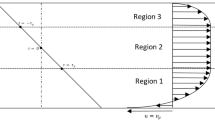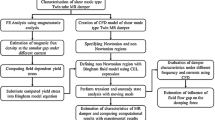Abstract
In the vehicle suspension system field, smart materials are contributing their top-notch characteristics in building up magneto-rheological (MR) dampers. Though MR fluid has good characteristics to absorb shock, sedimentation problem is a significant issue while performing an MR damper. MR grease eliminates the sedimentation problem and can be used a MR damper in vehicle suspensions system, in vibration control of large structures, biomedical, etc. This paper aims to conduct a numerical study based on coupled FEA and CFD and evaluate the damping force induced in the MR grease gap region for a different input current ranging from 0.1A to 0.4A at frequencies 1 Hz and 2 Hz. ANSYS CFX solver has been used with SST k-ω turbulence model and ‘Herschel-Bulkley’ model for the numerical simulation. At first the simulation approach/model was validated with the experimental results. Initially, the simulation was assumed to be a laminar flow, but as the piston of the damper moves for the stroke, the flow becomes turbulent. Without Shear Stress Transport (SST) turbulence model the simulation was unable to capture laminar to turbulent transition and suddenly stopped when the transition occurred without writing any result. Also, a comparison analysis between ‘Herschel-Bulkley’ fluid model and ‘Bingham’ model was done to prove that only the ‘Herschel-Bulkley’ fluid model can capture the rectangular curve of the damping force for MR Grease as it is stated by the authors who validated the experimental results for MR Grease. No numerical simulation has been found for characterizing MR Grease damper. The FEA has been used to determine the fluid properties due to various currents and frequencies, which were input for the CFD analysis to determine the damping forces and Quasi-static analysis. This simulation model could capture the hysteresis behavior correctly also.




























Similar content being viewed by others
References
Mata G T, Kumar H and Mahalingam A 2018 Performance analysis of a semi-active suspension system using coupled CFD-FEA based non-parametric modeling of low capacity shear mode monotube MR damper. Proceedings of the Institution of Mechanical Engineers, Part D: Journal of Automobile Engineering 233(5): 1214–1231
Ubaidillah, Sutrisno J, Purwanto A and Mazlan S A 2015 Recent Progress on Magnetorheological Solids: Materials, Fabrication, Testing, and Applications. Advanced Engineering Materials 17(5): 563–597
Hapipi N M, Mazlan S A, Ubaidillah U, Aziz S A A, Khairi M H A, Nordin N A and Nazmi N 2020 Solvent dependence of the rheological properties in hydrogel magnetorheological plastomer. International Journal of Molecular Sciences 21(5): 1793
Bastola A K and Hossain M 2020 A review on magneto-mechanical characterizations of magnetorheological elastomers. Composites Part B: Engineering 200: 108348
Yao X Y and Pecht M 2020 Dynamic response time model of metal foam magnetorheological damper. International Journal of Applied Electromagnetics and Mechanics 62(3): 491–500
Shiraishi T and Misaki H 2016 Vibration Control by a Shear Type Semi-active Damper Using Magnetorheological Grease. Journal of Physics: Conference Series 744(1)
Yu M, Ju B, Fu J, Liu S and Choi S B 2014 Magnetoresistance characteristics of magnetorheological gel under a magnetic field. Industrial and Engineering Chemistry Research 53(12): 4707–4710
Sahin H, Wang X and Gordaninejad F 2009 Temperature dependence of magneto-rheological materials. Journal of Intelligent Material Systems and Structures 20(18): 2215–2222
Sahin H and Gordaninejad F 2007 Wang X and Fuchs A 2007 Rheological behavior of magneto-rheological grease (MRG). Active and Passive Smart Structures and Integrated Systems 6525: 65250D
Sato Y, Sodeyama H, Hayama M and Morishita S 2015 An experimental study on basic characteristics of a magneto-rheological grease damper. American Society of Mechanical Engineers, Pressure Vessels and Piping Division (Publication) PVP 8: 1–8
Mohamad N, Mazlan S A and Choi S 2018 Improvement of magnetorheological greases with superparamagnetic nanoparticles. MATEC Web of Conferences 2018: 8–12
Mohamad N, Ubaidillah Mazlan S A, Imaduddin F, Choi S B and Yazid I I M 2018 A comparative work on the magnetic field-dependent properties of plate-like and spherical iron particle-based magnetorheological grease. PLoS ONE 13(4): 1–16
Mohamad N, Mazlan S A and Choi S 2016 The Field-Dependent Rheological Properties of Magnetorheological Grease Based on Carbonyl-Iron-Particles. Smart Materials and Structures 25(9): 1–10
Bahiuddin I, Wahab N A A, Shapiai M I, Mazlan S A, Mohamad N and ImaduddinUbaidillah F 2019 Prediction of field-dependent rheological properties of magnetorheological grease using extreme learning machine method. Journal of Intelligent Material Systems and Structures 30(11): 1727–1742
Gurubasavaraju T M, Kumar H and Mahalingam A 2018 An approach for characterizing twin-tube shear-mode magnetorheological damper through coupled FE and CFD analysis. Journal of the Brazilian Society of Mechanical Sciences and Engineering 40(3): 1–14
Elsaady W, Oyadiji S O and Nasser A 2019 A one-way coupled numerical magnetic field and CFD simulation of viscoplastic compressible fluids in MR dampers. International Journal of Mechanical Sciences. 167(October 2019)
Kemerli M and Engin T 2021 Numerical analysis of a monotube mixed mode magnetorheological damper by using a new rheological approach in CFD. Rheologica Acta 60(1): 77–95
Liu X and Wu D 2020 Performance evaluation of dampers under dynamic impact based on magnetic field Fe and CFD. IEEE Access 8(2020): 174643–174653
Elsaady W, Oyadiji S O and Nasser A 2020 Study of failure symptoms of a single-tube MR damper using an FEA-CFD approach. Journal of Intelligent Material Systems and Structures 2020: 8–12
Wang H, Li Y, Zhang G and Wang J 2019 Effect of temperature on rheological properties of lithium-based magnetorheological grease. Smart Materials and Structures 28(3): 035002
Mohamad N, Ubaidillah, Mazlan S A, Choi S B, Aziz S A A and Sugimoto M 2019 The effect of particle shapes on the field-dependent rheological properties of magnetorheological greases. International Journal of Molecular Sciences 20(7): 1525
“ValvolineTM Multi-Vehicle Grease: Product Catalog - ValvolineTM.” https://www.valvoline.com/our-products/grease-gear-oil/multi-purpose-grease
Ye X, Mao R and Wang J 2021 Analysis of magnetorheological grease normal force characteristics in static and dynamic shear modes. Materials Research Express 8(1): 015701
Wang K, Dong X, Li J, Shi K and Li K 2019 Effects of silicone oil viscosity and carbonyl iron particle weight fraction and size on yield stress for magnetorheological grease based on a new preparation technique. Materials 12(11): 1–17
Wang H, Zhang G and Wang J 2019 Quasi-Static Rheological Properties of Lithium-Based Magnetorheological Grease under Large Deformation. Materials 12(15): 2431
Zubieta M, Eceolaza S, Elejabarrieta M J and Bou-Ali M M 2009 Magnetorheological fluids: characterization and modeling of magnetization. Smart Materials and Structures 18(9): 095019
Sugiyama S, Sakurai T and Morishita S 2013 Vibration control of a structure using Magneto-Rheological grease damper. Frontiers of Mechanical Engineering 8(3): 261–267
Shah K, Oh J S, Choi S B and Upadhyay R V 2013 Plate-like iron particles based bidisperse magnetorheological fluid. Journal of Applied Physics. 114(21): 213904
Menter F R 1994 Two-equation eddy-viscosity turbulence models for engineering applications. AIAA Journal 32(8): 1598–1605
“ANSYS FLUENT 12.0 Theory Guide - 4.5.2 Shear-Stress Transport (SST) - Model.” https://www.afs.enea.it/project/neptunius/docs/fluent/html/th/node67.htm
Balasubramanian R, Barrows S and Chen J P 2008 Investigation of shear-stress transport turbulence model for turbomachinery applications. 46th AIAA Aerospace Sciences Meeting and Exhibit. 2008 (January): 7–10
Yin S, Jin D, Gui X and Zhu F 2010 Application and comparison of SST model in numerical simulation of the axial compressors. Journal of Thermal Science 19(4): 300–309
Wang P, Reviol T, Ren H and Böhle M 2019 Effects of turbulence modeling on the prediction of flow characteristics of mixing non-Newtonian fluids in a stirred vessel. Chemical Engineering Research and Design 147(2019): 259–277
“ANSYS FLUENT 12.0 User’s Guide - 8.4.5 Viscosity for Non-Newtonian Fluids.” https://www.afs.enea.it/project/neptunius/docs/fluent/html/ug/node297.htm
Bompos D A and Nikolakopoulos P G 2011 CFD simulation of magnetorheological fluid journal bearings. Simulation Modelling Practice and Theory 19(4): 1035–1060
Gedik E, Kurt H, Recebli Z and Balan C 2012 Computers & Fluids Two-dimensional CFD simulation of magnetorheological fluid between two fixed parallel plates applied external magnetic field. Computers and Fluids 63: 128–134
Sukhon R, Kongchana R, Khongsiri K, Puntaratronnugoon B and Tulasombut V 2010 A study on volumetric magnetic susceptibility of weight due to its manufacturing process. 21st Conference on Measurement of Force, Mass and Torque Together with HARDMEKO 2010 and 2nd Meeting on Vibration Measurement, IMEKO TC3, TC5 and TC22 Conferences, pp. 303–306
Li S, Schlamminger S and Pratt J 2014 A nonlinearity in permanent-magnet systems used in watt balances. Metrologia 51(5): 394
Jiusheng B, Zhencai Z, Yan Y and Shujin L 2009 Preparation and tribology performance of nano magnetic grease. Industrial Lubrication and Tribology 61(4): 228–231
Hu Z, Yan H, Yang J, Wang X and Yu R 2014 Effect of Components on Friction Property of Carbonyl Iron-Based Magnetorheological Fluid. Arabian Journal for Science and Engineering 39(10): 7355–7361
Arun M and Tulapurkara E G 2005 Computation of turbulent flow inside an enclosure with central partition. Progress in Computational Fluid Dynamics, an International Journal. 5(8): 455–465
Author information
Authors and Affiliations
Corresponding author
Rights and permissions
About this article
Cite this article
Ahammed, R., Hasan, M.Z. An FEA and CFD coupled numerical analysis approach for characterizing magneto-rheological (MR) grease damper. Sādhanā 48, 164 (2023). https://doi.org/10.1007/s12046-023-02196-y
Received:
Revised:
Accepted:
Published:
DOI: https://doi.org/10.1007/s12046-023-02196-y




